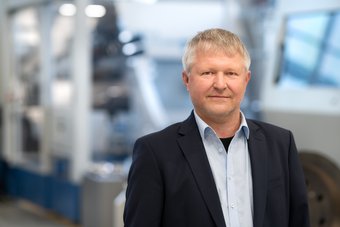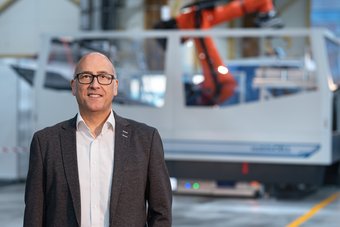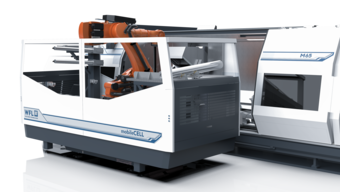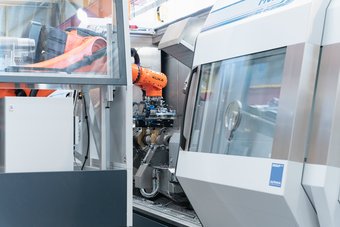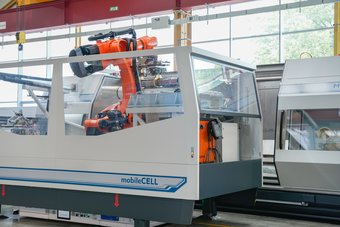Mobile Robot Automation - the interview
An interview with Sales Manager Andreas Bitzyk, FRAI Robotic Technologies and Managing Director Manfred Fahrion, Autania Engineering.
Automation tasks are becoming ever more challenging. Using intelligent software in combination with the relevant automation solutions not only enables workpieces to be loaded and unloaded but also means that machine tools can be set up fully automatically through automatic replacement of tools and clamping devices. FRAI strives to be an innovative automation partner and is therefore developing highly flexible robot systems to respond to this trend. Concepts such as the mobileCELL are a complete first and enable a wide range of expansion stages, making them as future-proof and competitive as possible.
Which technical innovations are there currently in regard to automation of work processes for a machine tool?
Manfred Fahrion: A general distinction must be made in regard to the industry in which the machine tools are being used and whether we are talking about pure series production or smaller batch sizes. Several industries are experiencing a paradigm shift, leaving many manufacturers unsure whether the latest product will still be on trend in the coming year or stuck on the shelves.
Autonomous production is also being increasingly sought after. Machines are equipped with larger tool magazines and automation must be able to keep up with this. So we have the following requirements for automation: it must ensure autonomous production 24/7, be flexible to use (product change) and compatible with Industry 4.0. In addition to the classic changeover of parts, automation also takes on the other tasks such as tool change, parts transport, logistics, host computer functions, part tracking and product history.
Andreas Bitzyk: If you want to retain flexibility and yet achieve a high degree of capacity utilisation for individual machines, then this places more demands on the automation. The more complex the task, the more elements you need from the „knowhow kit“.
The „knowhow kit“ is what I call the solutions that have already been successfully implemented in practice and work under real production conditions. FRAI has already developed a large number of kit elements: parts and position recognition, bin picking, reading and inscribing a DMC code, parts contour monitoring, automatic gripper exchange, jaw changes, etc. Depending on the task in question, we also have a network of partner companies which cover other aspects such as host computer solutions.
What is the current state of play in regard to automation in the industry and which developments do you foresee in the next two years?
Andreas Bitzyk: Overall networking, in particular information data acquisition, will become even more important in the coming years. We need to be able to acquire, process, evaluate and/or pass data on. This allows us to optimise production, the sequence and subsequently the capacity utilisation, and also meet customer requirements, which call for 100% traceability and parts history. Improving the capacity utilisation lowers unit costs, while higher quality lowers the cost of poor quality. These are well-known requirements, however they are becoming increasingly important. So in future, automation will be about using corresponding hardware to ensure a flexible material flow, handle components and also implement a variety of set-up processes.
Manfred Fahrion: There are several mega and macro trends which will shape not only automation, but also virtually all industrial sectors in the coming years. Firstly, we have individualisation: there will be smaller series and more frequent product changes/innovations. Secondly, we have connectivity: everything is networked, each component has a QR code and can be tracked through to recycling. If you think about a smartphone, making a phone call is no longer the key function. The same is true of automation, in the sense that transporting a workpiece from A to B is not necessarily the main task in every application. Instead, the focus has shifted towards recognition, tracking and multitasking. Camera recognition and gripper exchange systems combined with host computer solutions have become the core components of a flexible solution that is compatible with Industry 4.0. Globally, I believe the trend will move towards a small cell solution with high intelligence and a high proportion of IT.
What challenges need to be overcome?
Manfred Fahrion: When it comes to modern automation concepts, holistic customer support starts with the technical sales team. Here, experienced technicians must work hand in hand with visionaries, 3D designers and software specialists to create the most useful overall concept for the customer. These resources must be provided at both the quotation stage and also later on for order processing. This is a very challenging task for management. You have to train young people yourself and ensure a good mix in all departments so you are well prepared for the new tasks; develop high-tech expertise in your own company and continually adapt as development in these areas progresses at an incredible pace.
How does the new mobileCELL/the Mobile Robot Automation work?
Manfred Fahrion: Our mobileCELL is a hybrid solution, which impresses with its combination of wide-ranging functions and advantages. There was a time when the classic robot cell could only load and unload workpieces. This basic function was then enhanced with gripper exchange systems.
The disadvantages of the robot cell we are all familiar with are that the workpiece buffer is right in front of the machine and takes up valuable space on the production line and that the tools are tied to the machine locally, meaning they can only be used on this one machine. The robot is positioned directly in front of the machine, significantly limiting manual loading and access for measurement, etc. It can only be used on this machine, is location-bound; unless it is placed on a linear axis. However, this is often difficult, as the machines are not exactly in a line or next to one another. Then there is the matter of internal transport from machine A to B or to and from the warehouse.
Due to the significant disadvantages of a location-bound robot cell and the costs for intralogistics tasks, a solution was discussed which would produce advantages for the customer from the aforementioned disadvantages. This is how the concept of the mobile robot matured and was converted into a prototype.
A generously-sized automated guided vehicle (AGV) with a robot cell design with everything that you need. In other words, the robot, workpiece and tool gripper, along with buffer positions for workpieces and tools, and the necessary control & safety technology. As already mentioned, the machine is freely accessible. It is not blocked or obstructed. The AGV collects the required tools and workpieces in the warehouse, it then travels to the front of the machine, locks itself in place on the floor and exchanges parts and/or tools. The vehicle then moves away again and receives the travel instructions for the next machine. The space in front of the machine it has just loaded becomes clear again.
What preconditions must be met?
Andreas Bitzyk: For a mobileCELL to be useful, there has to be a long enough cycle time or there must be other advantages such as flexible, internal transport with the use of several mobile robots.
Manfred Fahrion: The travel paths must be suitably wide (3 m), but that is usually the case for normal forklift operation. The wheels are designed to travel over expansion joints and slots, such as we might have with fire doors or similar, without any problems. A virtual server and a WLAN network must be available, but that is also industry standard these days.
What are the advantages of automation with the mobileCELL?
Manfred Fahrion: The advantages offered the mobileCELL can be summarised as follows:
- Space saving in front of each machine that is being served
- Optimum access to the machine for operators and service personnel
- One robot can be used for several machines
- Interlinked machines and processes do not have to be in a line or next to one another
- The storage area is in the low cost warehouse space, not in the expensive production hall
- Tools can be used universally on several machines, they are not locally tied to individual machines
- Intralogistics costs are reduced, as the AGV takes the parts to the next process or to the warehouse
- Compatibility with machines that could not otherwise be automated or for which a separate robot cell would not be possible

